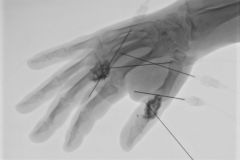Vascular malformations

Vascular malformations are congenital vascular structural building errors that are based on defective vascular maturation. Mostly, they are composed of a dominant vascular component (lymphatic system, veins, capillaries), with the exception of the arterio-venous malformations. Vascular malformations often occur in combination with dermal and accompanying mesenchymal tissue proliferation, clinically manifesting as circumscribed muscle, fat and bone hypertrophy.
According to their flow dynamics and the involved vascular components, vascular malformations are subdivided into slow-flow and fast-flow vessel anomalies. The most common vascular malformations are venous malformations (70%), followed by lymphatic (13%), capillary (10%) and arterio-venous malformations (7%). In contrast to vascular tumors, vascular malformations never undergo spontaneous regression, but may increase in size
The diagnosis of vascular malformations is based on clinical presentation, clinical history and the use of imaging modalities such as ultrasound, computed tomography, magnetic resonance imaging and angiography / phlebography. The therapeutic spectrum for the treatment of vascular malformation is composed of conservative and minimally invasive, rarely surgical measures and laser therapy. Compression therapy plays an important role here, as does sclerotherapy and embolisation. Often, multiple treatment sessions are required. For the treatment of patients with vascular malformations, a strict benefit-risk assessment as well as interdisciplinary patient care in many aspects of daily life are required.
